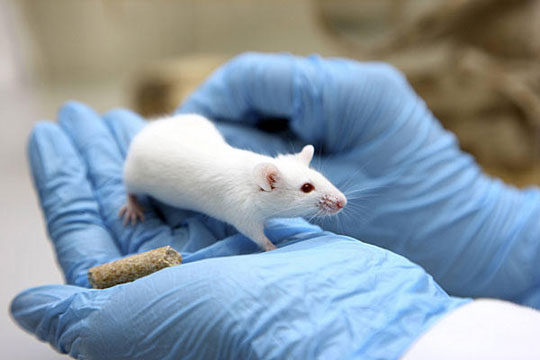Create mice that smell light
Among the characteristics of living things and humans, feeling the world around you with the sense of smell is still the most mysterious thing. To find out which areas of the brain are responsible for olfactory activity, the scientists created smelling mice . light by implanting genes responsible for synthesizing light-sensing proteins into cells in their nose.
>>>Listen to mice 'singing' like birds

Rats smell the light created in the laboratory. (Photo: Pravda).
Until now, scientists still do not know how our nervous system can process information and smell smells. The area of the brain responsible for this is also the least researched topic.
Studies are complex in that organisms often perceive not only one but many smells at the same time. Finding out which nerve cells respond to any of the many neurons is difficult. But recently a method has been found to untangle this messy " wind of smell ".
The group of scientists led by Professor of Molecular Biology and Cell V enkateshem Murthy, Harvard University conducted a very interesting experiment with the participation of a group of very talented white mice. You can ' smell ' . light rays. Your talents are brought about by gene technology.
People multiply the mucous membranes of the nose to be able to sense odors (essentially a combination of genes, involved in synthesizing protit, called rodopsin ) into these animals. Rodopsin has in the retina of animals' eyes, its function is to sense light. Thus, it is created in the olfactory organ of the mouse that the ability to react to light is like reacting to smell.
Why do people choose light as a stimulant in these experiments? Because most organisms only recognize a small portion of the spectrum of light, such as blue, red or purple. Meanwhile, we recognize almost all colors, but distinguish bad smell.
After creating mice that " smell light ", scientists put them in the light and see when the light comes into contact with the area of the brain that responds. Since then, a map of the areas of the mouse brain that have been stimulated when a 'light' of the light and the area of the hemisphere of the brain has been found to process odor information.

But scientists do not limit their olfactory studies to genetically engineered mice. Dr. Murthy said that the new method could be used to decipher any nerve segment that responds to complex stimuli such as sound waves or touch.
He said: " To find out how the brain feels smells, the best way is to find out which parts of the brain are stimulated. Doing this is quite difficult because if using the smell to stimulate olfactory receptors is the smell. The smell is too diverse and the nose usually only feels a combination of odor and not a single smell, finally we decided to change our 'odor analyzer' from nose to nose . eyes, equal "We believe that this method can be used to decipher any olfactory nerve segment that receives information from specific receptors and processes them ."
Currently in research people often use mutants to mutate the secrets of the brain. Last summer, a group of American scientists modified fruit flies that could ' smell light '. They grafted the rodopsin genes into the olfactory cell nucleus of these flies, so that in the olfactory cells of the olfactory nerve the flies already have light-sensing cells. As a result, the olfactory nerve of the fruit fly reacts with light blue as well as with unpleasant odors to them such as ethylprropionate and octylaxetate.
To re-examine how the light-sensing system works, scientists place the larvae of fruit flies that have mutated into glass plates, divided into two parts: a dark and partial part. Projector light blue. In the dark part, people spray octylaxetate with very strong odor intensity, but they still prefer to crawl into the dark areas. Obviously, the blue color has a frightening nose.
By the same method, people have created mice that can know exactly the smell of light waves. Unfortunately, they cannot tell us how to ' smell the light '.
- The mole rats eat the mouse rat manure to get instructions for raising children
- Scientists have created transparent mice
- Mine detection with genetically modified mice
- People smell 10 kinds of smell
- Gene-encoded mouse cells are controlled by light
- Successfully cloned mice from a drop of blood
- Interesting revelations about smell and smell
- Discover a new smell
- Mice recognize how different age?
- This man knows the smell of red green
- Relieve pain with light
- The truth is hard to believe: A pair of experimental mice can be as expensive as a billion-dollar car
 Why do potatoes have eyes?
Why do potatoes have eyes? 'Tragedy' the world's largest carnivorous life: Death becomes ... public toilet
'Tragedy' the world's largest carnivorous life: Death becomes ... public toilet Tomatoes were once considered 'poisonous' for 200 years
Tomatoes were once considered 'poisonous' for 200 years Detecting microscopic parasites on human face
Detecting microscopic parasites on human face